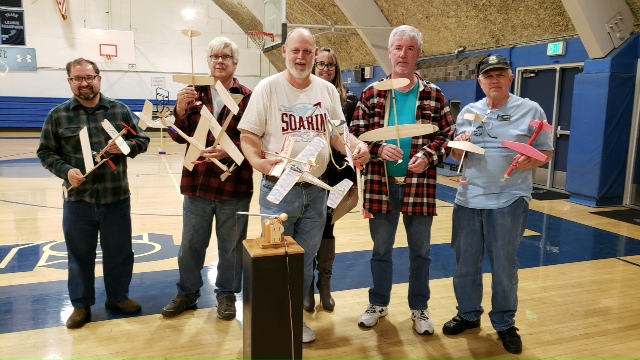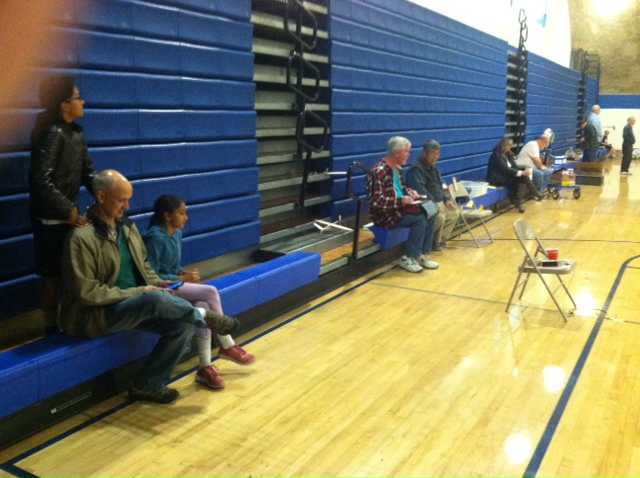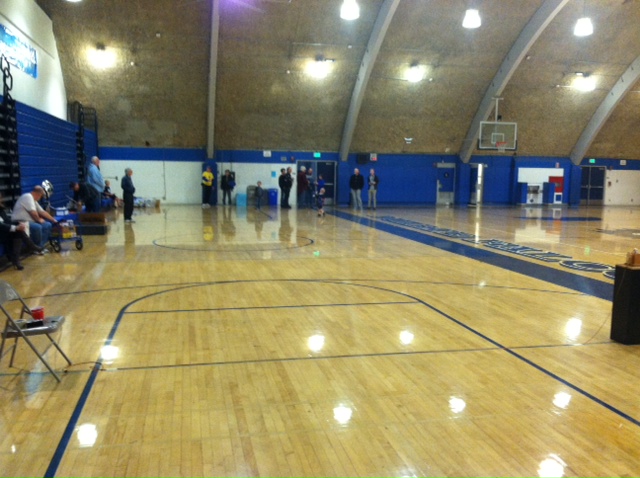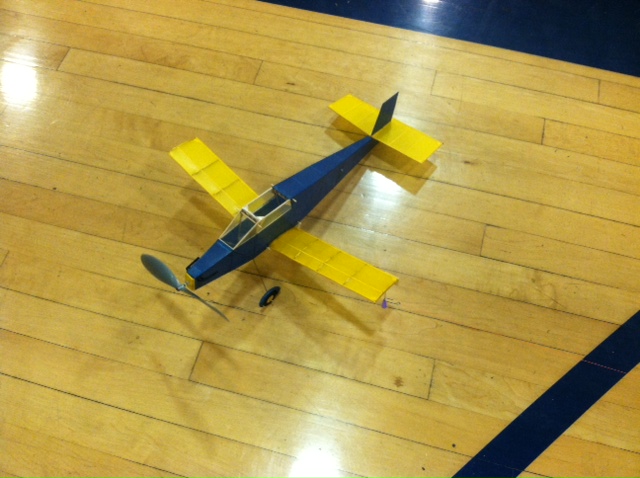Post by kittyfritters » Mon Feb 18, 2019 12:30 am
The contest was, if nothing else, a lot of fun! The attendance was a bit disappointing, but I'm sure that it will be better the next time we try it after the club members get the report on it at the next meeting.

- 20190216_210636.jpg (133.24 KiB) Viewed 17119 times
Since most of the Black Sheep members are in the San Fernando, Simi and Conejo valleys, it is a 45 minute to an hour (or more) drive to Duarte in Saturday night traffic. I realized that some of the more enthusiastic members, who are also in O.F.F.C. can no longer drive at night. They can't come to the Duarte sessions if they can't get a ride. We may have to work out a shuttle to get them there for contests. There were spectators since we share the site with the Santa Fe Dam RC fliers. We had the timing pylon set up in the northeast corner of the gym and the "low tech" pylon set up in the northwest corner for practice and trimming. This left space for some free flight and RC activity to take place in the rest of the space.

- RTP1.JPG (135.37 KiB) Viewed 17119 times

- RTP2.JPG (132.48 KiB) Viewed 17119 times
The flying was, if nothing else interesting. And, if the number of contestants was disappointing the number of models was not. No one showed up with less than two models. The faster models had two lap timings right around 3 seconds. Jim Leuken was to only one to get a sub 3 second time by the "brute force method". I don't know how many strands of 3/32", flat, tan he had on that flight but he used a Starlink Flight Tech motor strander, the same one he used for his Wakefield motors, to assemble it. And, that motor only worked for one flight. All of us were making motors all night. After a few flights we were using short, well lubricated, 4, 6, and 8 strand motors with about 600 to 750 turns. A motor would give about 3 competitive flights before going dead. I had a few feet of carefully stored Pirelli rubber left and I used it because it has a lot more torque than the F.A.I. tan at the start of the run. The problem with that was a bad launch was made even worse with all that torque. We also discovered that the rolled tube fuselage models were too small in diameter. They need to be at least 1-1/2 inches in diameter to hold more than a four strand motor. That doesn't mean they are not fast, a single loop of 1/4" Pirelli got my model into the 3 second (1-1/2 second laps) range with no trouble.
Those lap speeds caused another interesting problem. When you launch the model from the floor with the ten foot tether and the three foot pylon it's about 100 inches from the center of the circle. When it comes around again it's flying level with the pylon and it's 120 inches from the center of the circle. That means if you kneel down to launch the model and, stop to watch that it is flying stably when it crosses the timing line, 3/4 of a second later it's coming at your head at over 30 mph! (I don't care that the model only weighs 20 grams, it would still hurt!) I did that and ended on my ass avoiding getting hit, much to the amusement of everyone else. (Fortunately, no one got a video of that one.) The correct technique is to bend over to launch the model and take a step back.
Another thing about the launching is something that Jim Leuken, with experience flying control line speed models, picked up on. The model should be level when launched. That's why his models had under rudders to give them a level stance on the ground. He were the only launches that were consistently without drama. Some of the others occasionally ended in a wingover if the line did not stay taught. There were some flights that ripped up the course interspersed with some spectacular crashes and an occasional failure to fly resulting in an extremely fast taxi. All during the contest we were helping each other giving advise gleaned from our last flight. There were also some real surprises. Bill Watson's push-pull full fuselage model was not performing well, but he had also brought a box of Embryos in case he got the chance to do some free flying. (He did impress the RC fliers with his indoor towline glider!) He had built one of my Wright Amount of Wrong Embryos and saw that it had a long, skinny fuselage so he assembled it with just the bottom wing, rebalanced it with a more powerful motor, put a pin in the wing tip to anchor the tether, and finished third in the full fuselage class!

- RTP7.JPG (118.79 KiB) Viewed 17119 times
The results were:
Unlimited
1. Jim Leuken
2. Bill Watson
3. Howard Littman
Covered Motor
1. Howard Littman
2. Dave Gee
3. Bill Watson
The contest was, if nothing else, a lot of fun! The attendance was a bit disappointing, but I'm sure that it will be better the next time we try it after the club members get the report on it at the next meeting.
[attachment=3]20190216_210636.jpg[/attachment]
Since most of the Black Sheep members are in the San Fernando, Simi and Conejo valleys, it is a 45 minute to an hour (or more) drive to Duarte in Saturday night traffic. I realized that some of the more enthusiastic members, who are also in O.F.F.C. can no longer drive at night. They can't come to the Duarte sessions if they can't get a ride. We may have to work out a shuttle to get them there for contests. There were spectators since we share the site with the Santa Fe Dam RC fliers. We had the timing pylon set up in the northeast corner of the gym and the "low tech" pylon set up in the northwest corner for practice and trimming. This left space for some free flight and RC activity to take place in the rest of the space.
[attachment=2]RTP1.JPG[/attachment]
[attachment=1]RTP2.JPG[/attachment]
The flying was, if nothing else interesting. And, if the number of contestants was disappointing the number of models was not. No one showed up with less than two models. The faster models had two lap timings right around 3 seconds. Jim Leuken was to only one to get a sub 3 second time by the "brute force method". I don't know how many strands of 3/32", flat, tan he had on that flight but he used a Starlink Flight Tech motor strander, the same one he used for his Wakefield motors, to assemble it. And, that motor only worked for one flight. All of us were making motors all night. After a few flights we were using short, well lubricated, 4, 6, and 8 strand motors with about 600 to 750 turns. A motor would give about 3 competitive flights before going dead. I had a few feet of carefully stored Pirelli rubber left and I used it because it has a lot more torque than the F.A.I. tan at the start of the run. The problem with that was a bad launch was made even worse with all that torque. We also discovered that the rolled tube fuselage models were too small in diameter. They need to be at least 1-1/2 inches in diameter to hold more than a four strand motor. That doesn't mean they are not fast, a single loop of 1/4" Pirelli got my model into the 3 second (1-1/2 second laps) range with no trouble.
Those lap speeds caused another interesting problem. When you launch the model from the floor with the ten foot tether and the three foot pylon it's about 100 inches from the center of the circle. When it comes around again it's flying level with the pylon and it's 120 inches from the center of the circle. That means if you kneel down to launch the model and, stop to watch that it is flying stably when it crosses the timing line, 3/4 of a second later it's coming at your head at over 30 mph! (I don't care that the model only weighs 20 grams, it would still hurt!) I did that and ended on my ass avoiding getting hit, much to the amusement of everyone else. (Fortunately, no one got a video of that one.) The correct technique is to bend over to launch the model and take a step back.
Another thing about the launching is something that Jim Leuken, with experience flying control line speed models, picked up on. The model should be level when launched. That's why his models had under rudders to give them a level stance on the ground. He were the only launches that were consistently without drama. Some of the others occasionally ended in a wingover if the line did not stay taught. There were some flights that ripped up the course interspersed with some spectacular crashes and an occasional failure to fly resulting in an extremely fast taxi. All during the contest we were helping each other giving advise gleaned from our last flight. There were also some real surprises. Bill Watson's push-pull full fuselage model was not performing well, but he had also brought a box of Embryos in case he got the chance to do some free flying. (He did impress the RC fliers with his indoor towline glider!) He had built one of my Wright Amount of Wrong Embryos and saw that it had a long, skinny fuselage so he assembled it with just the bottom wing, rebalanced it with a more powerful motor, put a pin in the wing tip to anchor the tether, and finished third in the full fuselage class!
[attachment=0]RTP7.JPG[/attachment]
The results were:
Unlimited
1. Jim Leuken
2. Bill Watson
3. Howard Littman
Covered Motor
1. Howard Littman
2. Dave Gee
3. Bill Watson
